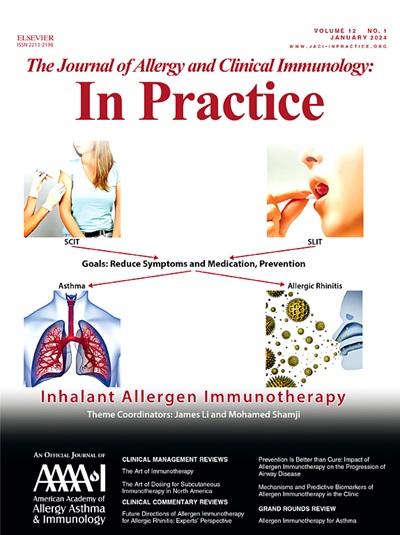慢性荨麻疹抗组胺药物临床反应的预后计算器:外部验证。
IF 6.6
1区 医学
Q1 ALLERGY
Journal of Allergy and Clinical Immunology-In Practice
Pub Date : 2025-09-01
DOI:10.1016/j.jaip.2025.05.051
引用次数: 0
摘要
背景:抗组胺药(antiH1)是治疗慢性自发性荨麻疹(CSU)的一线药物,但40%至60%的患者无法通过该疗法获得临床控制。早期识别无反应的患者可以立即开始其他治疗。目的:该研究的目的是实现对成人CSU患者抗h1临床反应的预后计算器的外部验证。方法:预后计算器包括临床预约时容易获得的五个变量(年龄、血管性水肿、焦虑/抑郁、发病时间、非甾体类抗炎药过敏和荨麻疹活动评分(UAS))。来自四个不同国家的CSU患者在服用抗组胺药前后进行了评估。校正和鉴别用于评估预后准确性。主要终点是抗组胺药的临床反应,用7天的UAS (UAS7)进行评估:“对照组”定义为UAS7分。结果:共纳入542例患者。预后模型表现出一致性(准确率78.6%,HL 0.89, AUC 0.829)。该模型正确预测了82.9%的UAS7患者和72.7%的UAS7患者。结论:该预测计算器在临床实践中是一种有用的工具,可根据抗组胺药的个体反应概率,早期采用个性化治疗方法,有可能减少次优治疗的时间。本文章由计算机程序翻译,如有差异,请以英文原文为准。
Prognostic Calculator of the Clinical Response to Antihistamines in Chronic Urticaria: External Validation
Background
Antihistamines (antiH1) are the first-line treatment for chronic spontaneous urticaria (CSU), but 40% to 60% of patients do not achieve clinical control with this therapy. Early identification of the non-responder patients could undergo prompt initiation of other therapies.
Objective
To achieve external validation of a prognostic calculator of clinical response to antiH1 in adult patients with CSU.
Methods
The prognostic calculator consisted of five variables easily accessible during clinical appointments (age, angioedema, anxiety or depression, duration of the disease, nonsteroidal anti-inflammatory drug hypersensitivity, and urticaria activity score (UAS). Patients with CSU from four countries were evaluated before and after antihistamine administration. Calibration and discrimination were used to evaluate prognostic accuracy. The main outcome, clinical response to antihistamines, was evaluated with the UAS for 7 days (UAS7). Control was defined as a UAS7 score less than 6 and no control was defined as UAS7 greater than 7 points.
Results
A total of 542 patients were included. The prognostic model performance demonstrated consistency (accuracy of 78.6%; Hosmer-Lemeshow, 0.89; area under the curve, 0.829). The model correctly predicted 82.9% of patients with UAS7 greater than 7 and 72.7% of patients with UAS7 less than 6. Patients without antiH1 control had more frequent autoimmune disease and inducible urticaria, and patients with antiH1 control had higher levels of total IgE and a higher frequency of IgE anti-thyroperoxidase, IgE anti-eosinophil peroxidase and IgE anti-eosinophil cationic protein.
Conclusion
This prognostic calculator was demonstrated to be a useful tool in clinical practice for an early personalized therapeutic approach according to the individual probability of response with antihistamines, potentially reducing time with suboptimal treatments.
求助全文
通过发布文献求助,成功后即可免费获取论文全文。
去求助
来源期刊

Journal of Allergy and Clinical Immunology-In Practice
ALLERGYIMMUNOLOGY-IMMUNOLOGY
CiteScore
11.10
自引率
9.60%
发文量
683
审稿时长
50 days
期刊介绍:
JACI: In Practice is an official publication of the American Academy of Allergy, Asthma & Immunology (AAAAI). It is a companion title to The Journal of Allergy and Clinical Immunology, and it aims to provide timely clinical papers, case reports, and management recommendations to clinical allergists and other physicians dealing with allergic and immunologic diseases in their practice. The mission of JACI: In Practice is to offer valid and impactful information that supports evidence-based clinical decisions in the diagnosis and management of asthma, allergies, immunologic conditions, and related diseases.
This journal publishes articles on various conditions treated by allergist-immunologists, including food allergy, respiratory disorders (such as asthma, rhinitis, nasal polyps, sinusitis, cough, ABPA, and hypersensitivity pneumonitis), drug allergy, insect sting allergy, anaphylaxis, dermatologic disorders (such as atopic dermatitis, contact dermatitis, urticaria, angioedema, and HAE), immunodeficiency, autoinflammatory syndromes, eosinophilic disorders, and mast cell disorders.
The focus of the journal is on providing cutting-edge clinical information that practitioners can use in their everyday practice or to acquire new knowledge and skills for the benefit of their patients. However, mechanistic or translational studies without immediate or near future clinical relevance, as well as animal studies, are not within the scope of the journal.
 求助内容:
求助内容: 应助结果提醒方式:
应助结果提醒方式:


